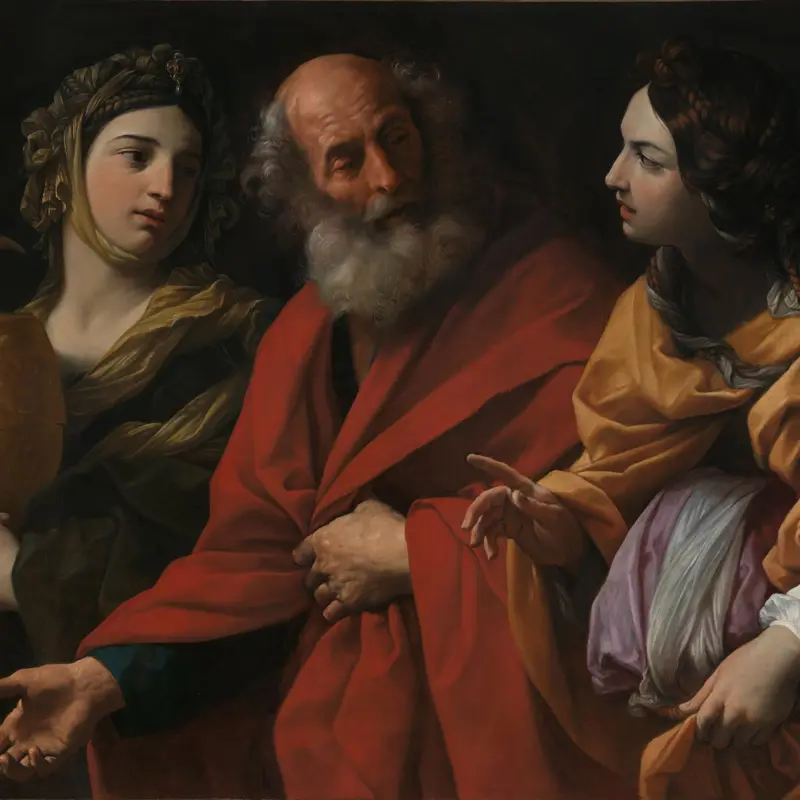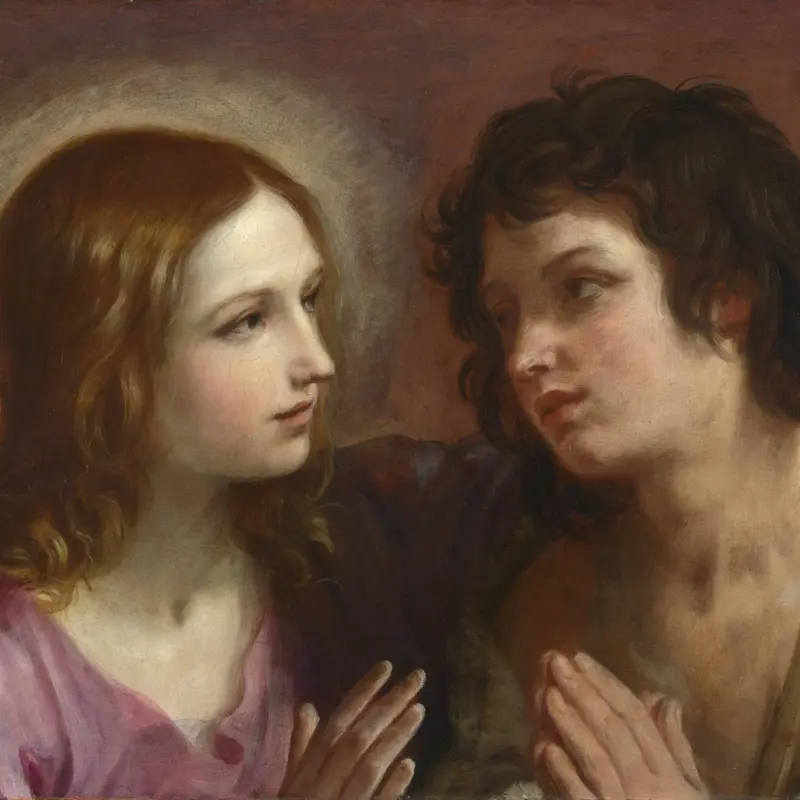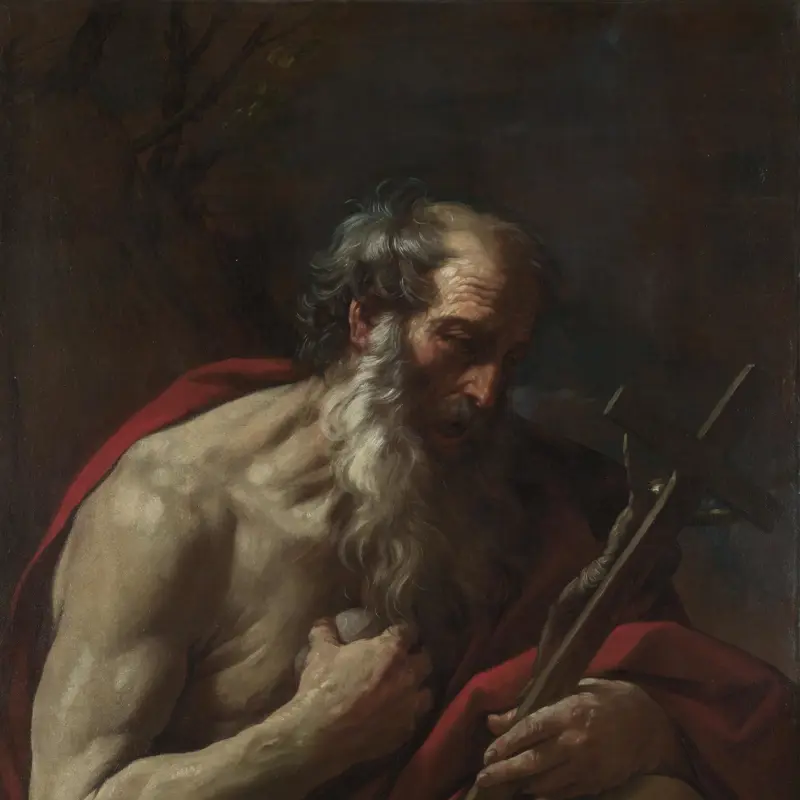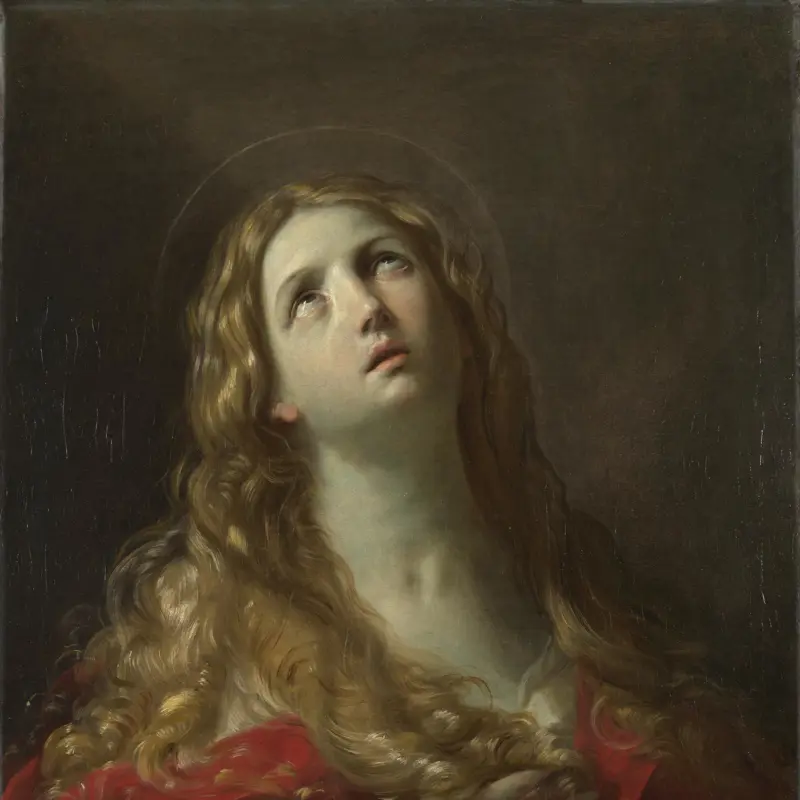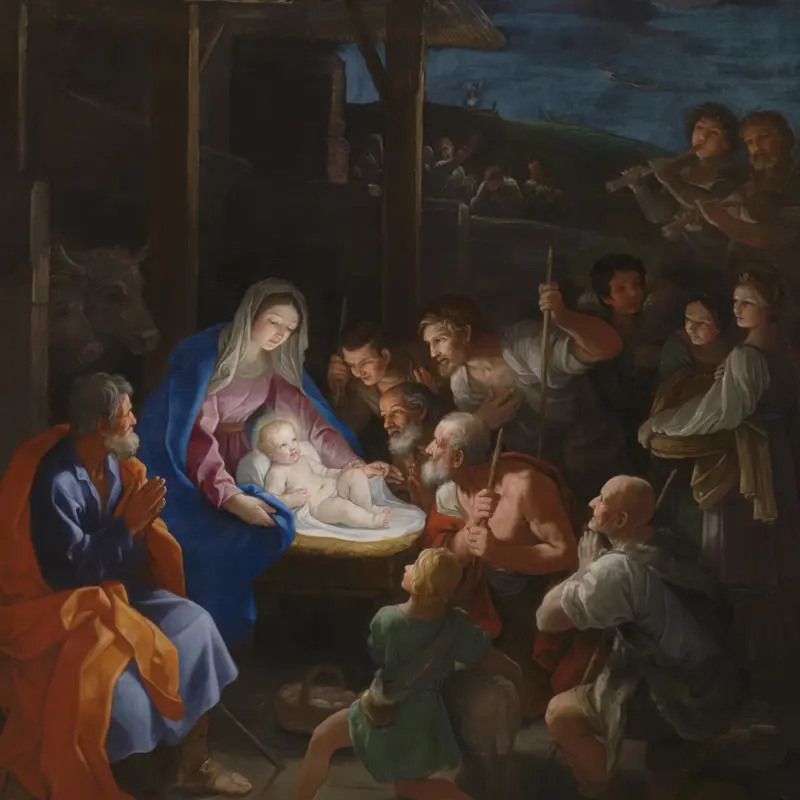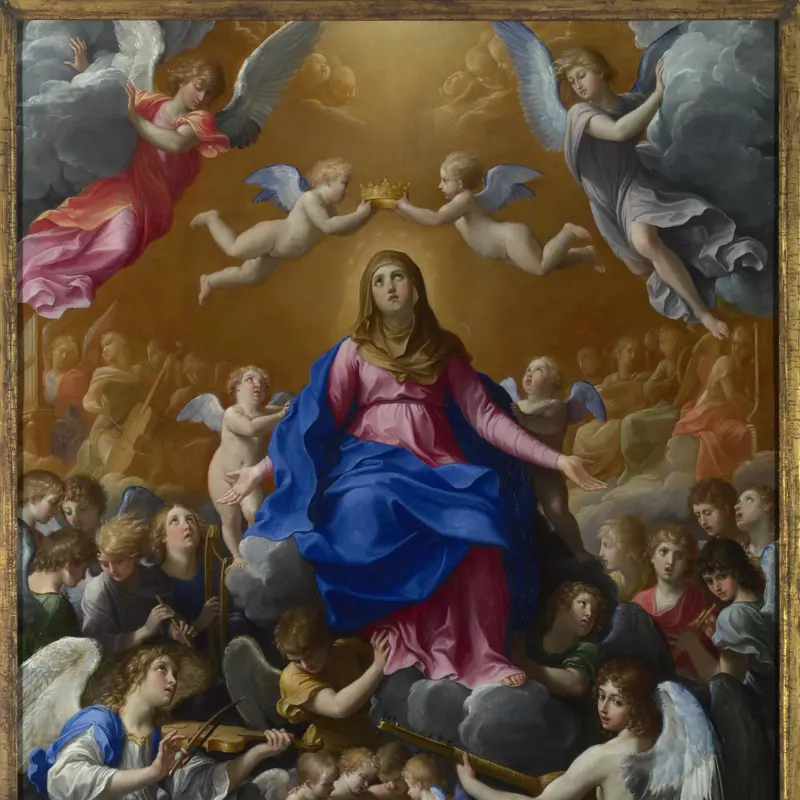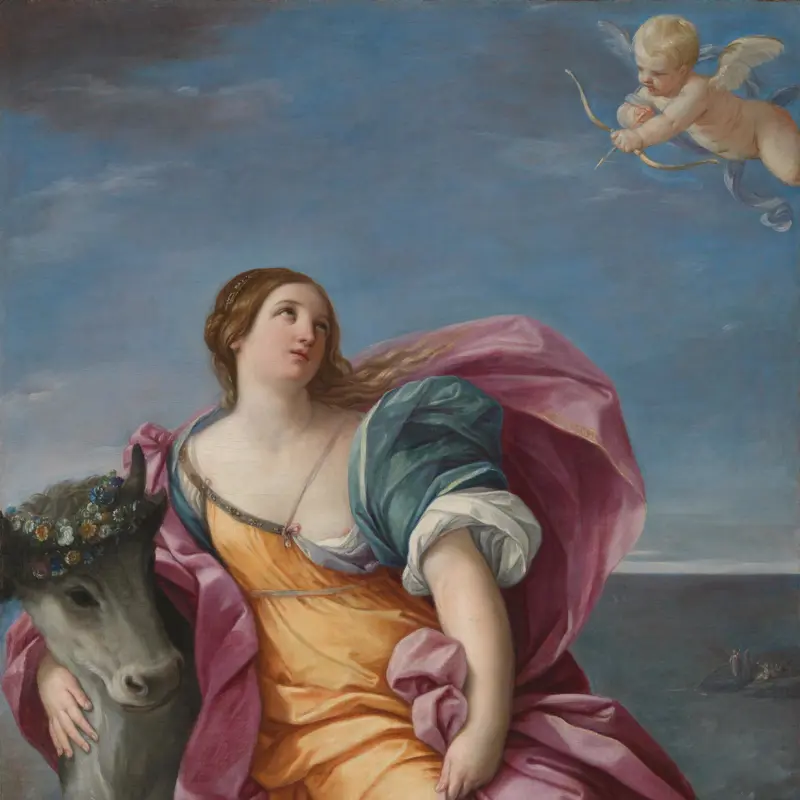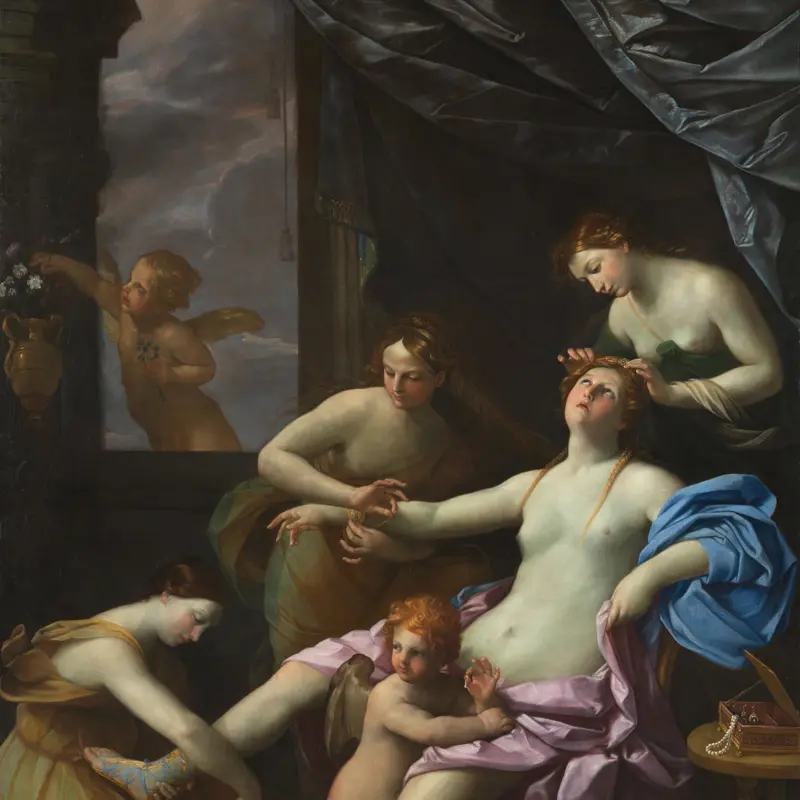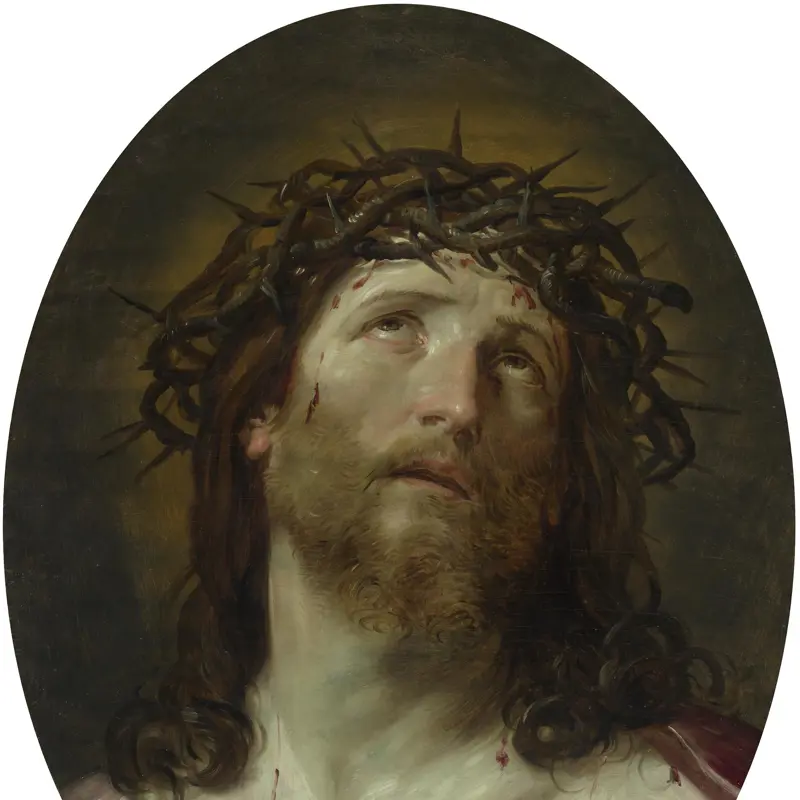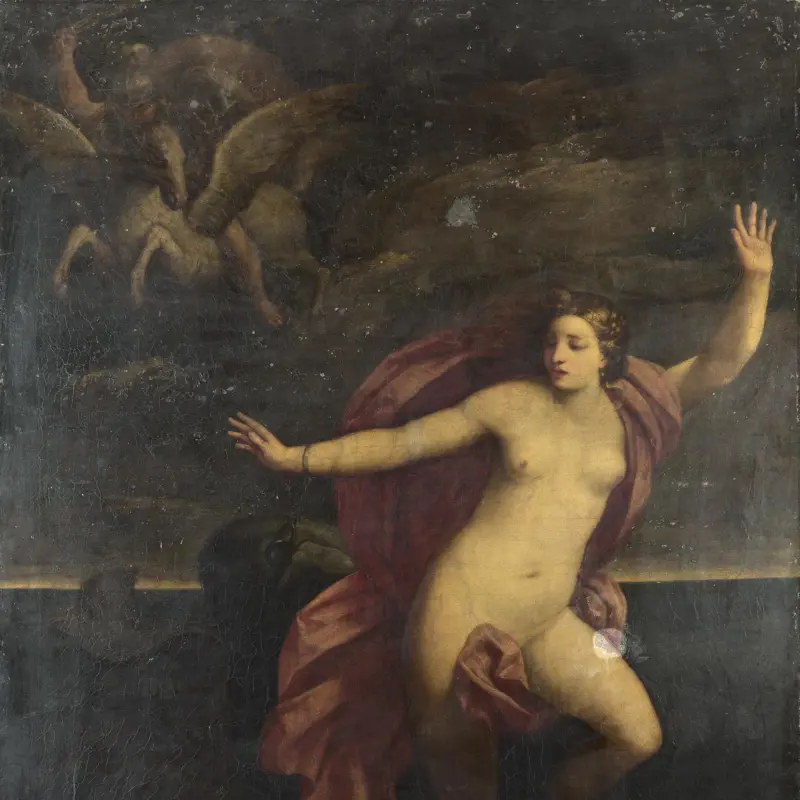Guido Reni, 'Lot and his Daughters leaving Sodom', about 1614-15
About the work
Overview
Lot and his daughters are shown fleeing the sinful city of Sodom, forewarned by God of its destruction (Genesis 19). The family are in a moment of conversation, perhaps contemplating their next move. Conspicuously absent are details typically associated with the subject, such as Sodom burning in the background or elements of eroticism, alluding to the daughters' later seduction of their father (an attempt to continue their family’s bloodline). Instead, the trio are fully clothed, sober and chaste.
This painting was made around the time of Reni’s celebrated Aurora fresco in Rome, where he lived and worked for more than a decade; the statuesque figures and solid handling of paint are illustrative of the style that he had developed there. Since the mid-seventeenth century, this painting has been regarded as a companion piece to Susannah and the Elders (also in the National Gallery’s collection). Though similar in format and both illustrating moralising tales, the two were painted a few years apart, and were not originally intended as a pair.
Key facts
Details
- Full title
- Lot and his Daughters leaving Sodom
- Artist
- Guido Reni
- Artist dates
- 1575 - 1642
- Part of the series
- Two Biblical Scenes from Palazzo Lancellotti
- Date made
- About 1614-15
- Medium and support
- Oil on canvas
- Dimensions
- 111.2 × 149.2 cm
- Acquisition credit
- Bought, 1844
- Inventory number
- NG193
- Location
- Room 32
- Collection
- Main Collection
- Frame
- 17th-century Italian Frame
Provenance
Additional information
Text extracted from the ‘Provenance’ section of the catalogue entry in Michael Levey, ‘National Gallery Catalogues: The Seventeenth and Eighteenth Century Italian Schools’, London 1986; for further information, see the full catalogue entry.
Exhibition history
-
2016Beyond CaravaggioThe National Gallery (London)12 October 2016 - 15 January 2017National Gallery of Ireland11 February 2017 - 14 May 2017Scottish National Gallery17 June 2017 - 24 September 2017
-
2022Guido Reni and Rome: Nature and DevotionMuseo e Galleria Borghese28 February 2022 - 24 May 2022
-
2022Guido Reni: The Beauty of the DivineStädelsches Kunstinstitut und Städtische Galerie23 November 2022 - 5 March 2023
Bibliography
-
1760Bologna, Biblioteca Communale dell' Archiginnasio, MS B 126: M. Oretti, Notizie de' professori del disegno, cioè dei pittori, scultori ed architetti bolognesi e di forestieri di sua scuola, 1760 - 1780
-
1770G.F. Pagani, Le pitture, e sculture di Modena, Modena 1770
-
1771G. Hamilton, Schola italica picturae, Rome 1771
-
1787F.W.B. von Ramdohr, Über Mahlerei und Bildhauerarbeit in Rom für Liebhaber des Schönen in der Kunst, Leipzig 1787
-
1791M. Vasi, Itinerario di Roma, Rome 1791
-
1818H. Tresham, W.Y. Ottley and P.W. Tomkins, The British Gallery of Pictures, London 1818
-
1824W. Buchanan, Memoirs of Painting: With a Chronological History of the Importation of Pictures by the Great Masters into England Since the French Revolution, London 1824
-
1844Christie & Manson, Catalogue of the Celebrated Collection of Pictures, of the Very Highest Class: The Property of John Penrice, Esq., London, 16 July 1844
-
1845G. Foggo, A Catalogue of the Pictures in the National Gallery with Critical Notes, London 1845
-
1845T. Penrice, Letters Addressed to the Late Thomas Penrice, Esq., while Engaged in Forming His Collection of Pictures, 1808-1814, ed. J. Penrice, Yarmouth 1845
-
1853National Gallery, Report from the Select Committee on the National Gallery, together with the Proceedings of the Committee, Minutes of Evidence, Appendix, and Index, London 1853
-
1853London, National Gallery Archive, NG15/3: Report from the Select Committee on the National Gallery, together with the Proceedings of the Committee, Minutes of Evidence, Appendix, and Index, 1853
-
1878H. Blackburn, Illustrated Catalogue to the National Gallery: Foreign Schools, London 1878
-
1888E.T. Cook, A Popular Handbook to the National Gallery Including, by Special Permission, Notes Collected from the Works of Mr. Ruskin, London 1888
-
1913C. Stryienski, La galerie du régent, Philippe, duc d'Orléans, Paris 1913
-
1928W.T. Whitley, Art in England 1800-1820, Cambridge 1928
-
1929F. Malaguzzi Valeri, Guido Reni, Florence 1929
-
1955C. Gnudi and G.C. Cavalli, Guido Reni, Florence 1955
-
1955O. Kurz, Bolognese Drawings of the Xvii and Xviii Centuries at Windsor Castle, London 1955
-
1965H. Hibbard, 'Note on Reni's Chronology', The Burlington Magazine, CVII, 1965, pp. 502-10
-
1971E. Baccheschi, L'opera completa di Guido Reni, Milan 1971
-
1971L. Düssler, Raphael: A Critical Catalogue of His Pictures, Wall-Paintings and Tapestries, trans. S. Cruft, London 1971
-
1971M. Levey, The Seventeenth and Eighteenth Century Italian Schools, London 1971
-
1975M. Mancigotti, Simone Cantarini: Il pesarese, Pesaro 1975
-
1978D. Robertson, Sir Charles Eastlake and the Victorian Art World, Princeton 1978
-
1978C. Gould, The Draped Figure, Themes and Painters in the National Gallery 2, 2nd edn, London 1978
-
1978Sotheby's, Sale Catalogue, London, 22 March 1978
-
1982H. Brigstocke and W. Buchanan, William Buchanan and the 19th Century Art Trade: 100 Letters to his Agents in London and Italy, London 1982
-
1984D.S. Pepper, Guido Reni: A Complete Catalogue of His Works, Oxford 1984
-
1984W. Busch, 'Hogarths und Reynolds Porträts des Schauspielers Garrick', Zeitschrift für Kunstgeschichte, XLVII, 1984, pp. 82-99
-
1984C. Swaton-Escoffre and H. Wytenhove, Peintures italiennes du Musée des Beaux-Arts de Marseille (exh. cat. Palais Longchamp, October 1984 - February 1985), Marseille 1984
-
1985U. Schlegel, 'Bernini und Guido Reni', Jahrbuch der Berliner Museen, XXVII, 1985, pp. 101-45
-
1986Levey, Michael, National Gallery Catalogues: The Seventeenth and Eighteenth Century Italian Schools, London 1986
-
1988D.S. Pepper, Guido Reni: L'opera completa, Novara 1988
-
1988V. Birke and B. Dossi, Guido Reni und der Reproduktionsstich, (exh. cat. Albertina, 15 September - 13 November 1988), Vienna 1988
-
1988S.L. Caroselli, Guido Reni, 1575-1642 (exh. cat. Pinacoteca Nazionale, 5 September - 13 November 1988; Los Angeles County Museum of Art, 11 December 1988 - 12 February 1989; Kimbell Art Museum, 11 March - 14 May 1989), Bologna 1988
-
1994E. Langmuir, The National Gallery Companion Guide, London 1994
-
1994A. Thomas, An Illustrated Dictionary of Narrative Painting, London 1994
-
1996G. Papi, 'Il Monogrammista RG e un indizio per Terbrugghen in Italia', Paragone, 551-553, 1996, pp. 97-106
-
1997R.E. Spear, The 'Divine' Guido: Religion, Sex, Money, and Art in the World of Guido Reni, New Haven 1997
-
2001
C. Baker and T. Henry, The National Gallery: Complete Illustrated Catalogue, London 2001
About this record
If you know more about this work or have spotted an error, please contact us. Please note that exhibition histories are listed from 2009 onwards. Bibliographies may not be complete; more comprehensive information is available in the National Gallery Library.
Images
About the series: Two Biblical Scenes from Palazzo Lancellotti
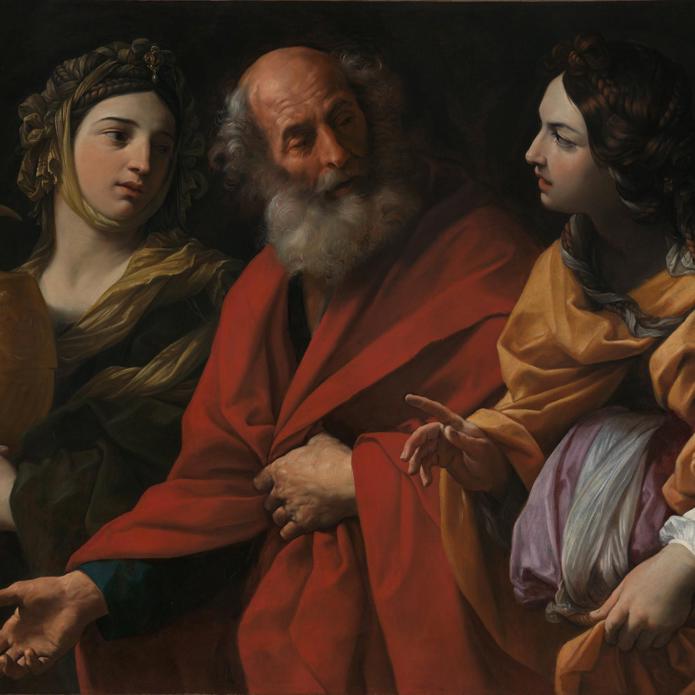
Overview
Lot and his Daughters Leaving Sodom and Susannah and the Elders are two works by Guido Reni, both of which depict biblical scenes containing three figures. They are of similar size, and are painted in a horizontal format with dark backgrounds. The two were first recorded in the Palazzo Lancellotti, Rome, in 1640, where they hung together as companion pieces until they were respectively acquired by the National Gallery in 1844.
Upon their acquisition the works were considered to be a pair, given their similarly moralising subject matter, size, and location in the Palazzo Lancellotti. However, cleaning revealed brushwork that suggests the paintings were created in different periods of Reni’s career, and were not made to hang together.
Because the two Old Testament subjects illustrate feminine vice and virtue, the pairing would seem to be deliberate. It’s possible that Reni painted Susannah and the Elders to accompany his earlier work, but it’s similarly plausible that the pairing was made by a collector much later.

